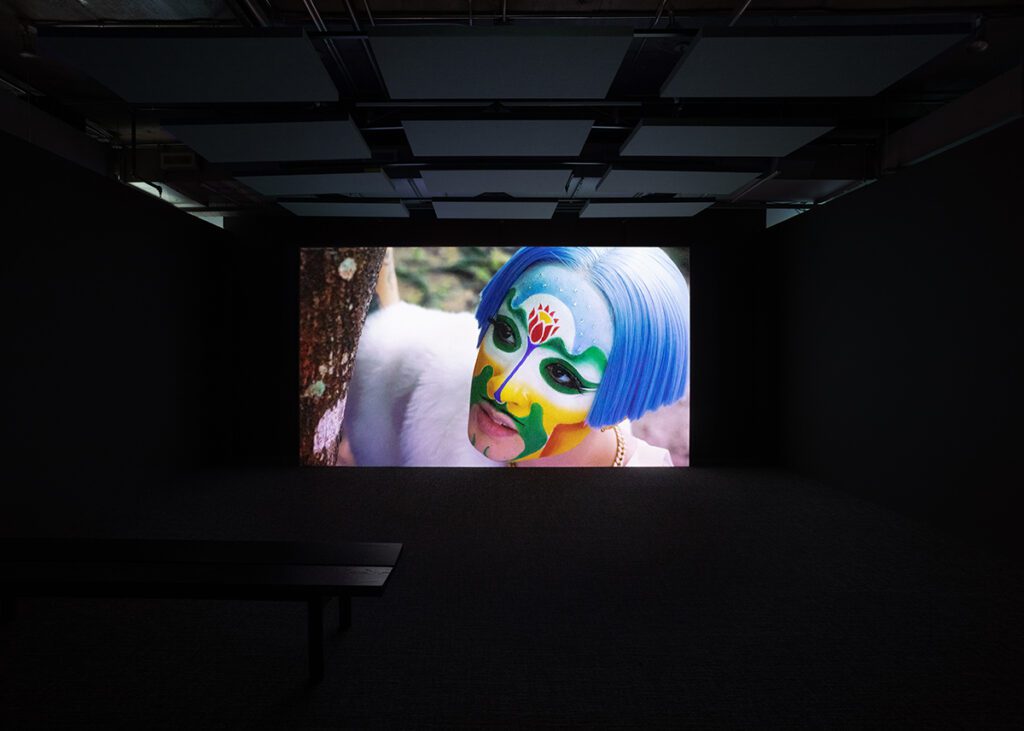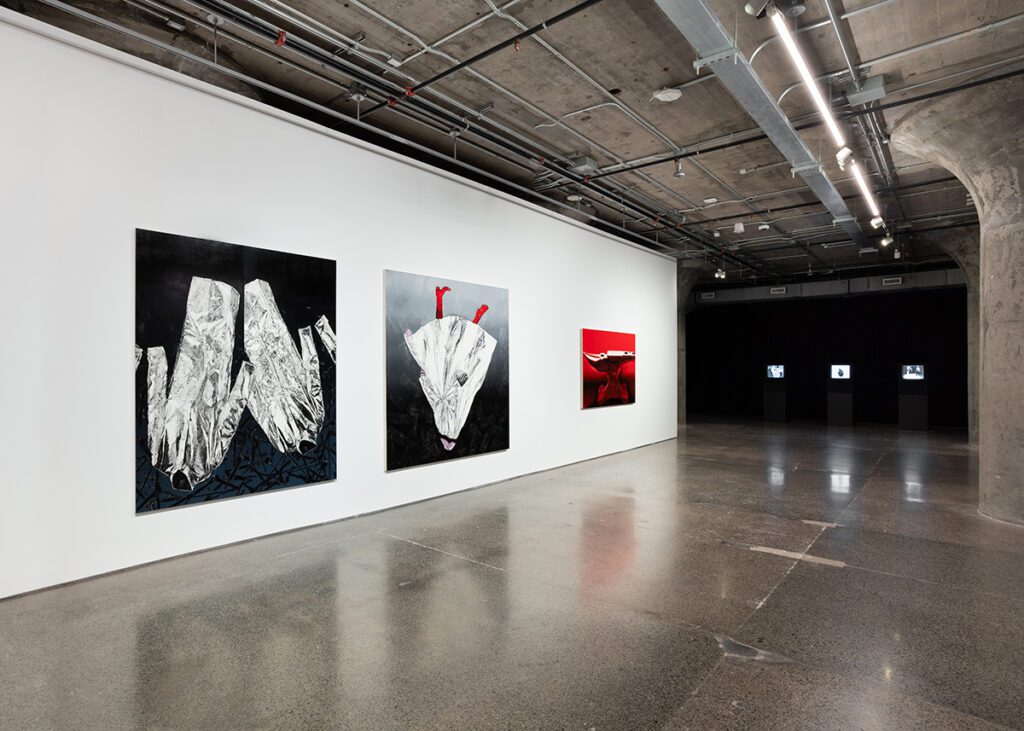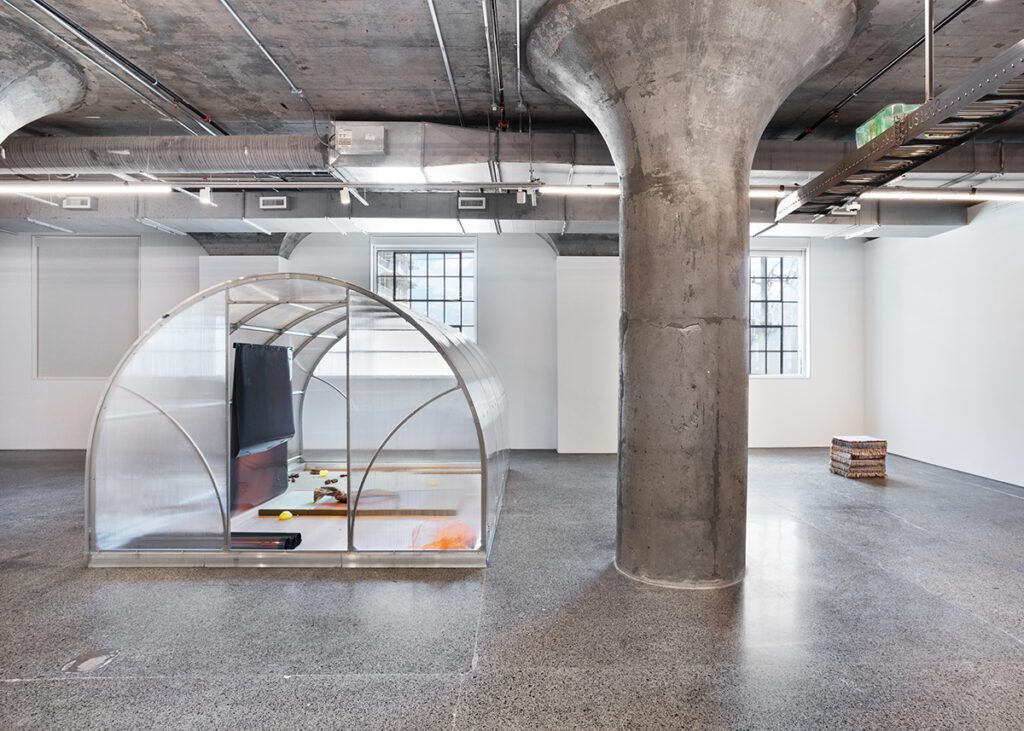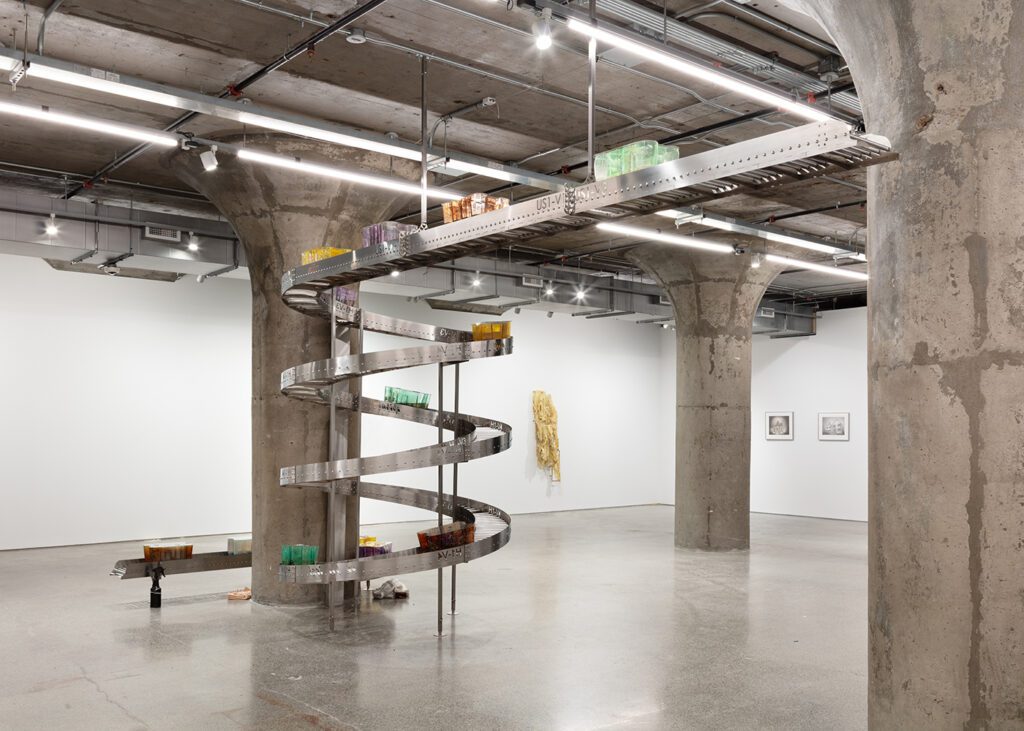Ok, I’ll Bite: What’s Toronto? GTA24 at MOCA Toronto
26 July 2024By Erika Verhagen

BELLYACHING FOR FUN & PROFIT
Have you heard the Bill Evans Trio album of recordings from 1961, At the Village Vanguard? A classic. Evans plinking away at the piano amongst the clinking glasses, scraping cutlery, and chattering diners of the famed New York City jazz venue—an occasional percussive cough thrown in for good measure. It’s an ideal album for when you want to be reminded that music is at its best when rooted in a physical reality, in a community. Perhaps this is what GTA24, the second edition of MOCA’s Greater Toronto Art Triennial, was going for when they afixed Mani Mazinani’s sound-based installation, Solar Scale (2024), beneath the museum’s clamorous HVAC system and a stone’s throw from the lobby cafe-bakery.
Then again, perhaps not. The didactic text for Solar Scale offers phrases like “harmonic pulsations” and “invented and ancient pentatonic scales” but fails to suggest that the sounds of the nearby espresso machine might be central to the work. This is the crux of the issue I’ve encountered in writing about this show: one must try very hard to write around the container in order to get at its contents. Do I relish the opportunity to complain about the scarcity of seating in front of various video works? Am I banging down doors to grumble about the dismissive installation of Ésery Mondésir’s video, The Mother Was Feeding it Alright (2019), tucked in beside the coatroom? Do I like chiding a museum for its too-dim third-floor lighting, or for leaving a gap of approximately a metre and a half between the ceiling and a sound-dampening wall?
Yes, actually; I am nothing if not a prolific complainer and a pedant. Little causes me such delirious joy as expecting the worst and having it confirmed. Unfortunately, there’s also nothing quite worse than expecting a slam dunk that never materializes. Not to plagiarize every Pitchfork review of a band’s faltering sophomore record, but I ought to come out and say it: GTA24 does not distinguish itself from its 2021 predecessor, neither in presentation nor in perspective, nor even in the quality of individual artworks. Despite the advantage of a change in curatorial team, it delivers only diminishing returns on a concept that could have plausibly been inventive three years ago – instead, it comes off significantly less so in 2024.
SO, HERE IS WHAT I LIKED:
Sukaina Kubba’s Enclave Exclave (31-32 Oakville, Ontario) (2023-24), an installation of wall-mounted rug motifs drawn with extruded plastic filament, had a very peculiar and pleasing way of arriving at delicateness via the path of flimsiness. Tim Whiten’s Chestnut & Almond (1973), twin felled saplings wrapped in leather, looked like a pair of massive asparagus wearing driving gloves. Oliver Husain and Kerstin Schroedinger’s two-channel video installation DNCB (2021), exploring the use of dinitrochlorobenzene (a chemical used primarily in colour film processing) as an experimental AIDS treatment in the 1980s-’90s was well-considered, alluring, and deeply upsetting in equal measure. The Turner Prize-nominated film, A Dream of Wholeness in Parts (2021), by Toronto-born and UK-based artist Sin Wai Kin, deploys a fantastically calm second-person narration and a banyan tree speaking through a mouth made out of a digitally inserted wave to form what might have been a compelling centrepiece to a more connected show.

Perhaps these are all examples of what the exhibition text means by “artistic strategies of working with, on, and against dominant cultural forms.” Though, I am not convinced there is much in this world that could not be described as working “with, on, or against” something. Are all of these works representative of the “crucial roles artistic language plays in developing more sustainable and caring ways of living together, and in building solidarity?” Solidarity with what, or whom, exactly? Did I miss the meeting at which we all agreed to this new toothless version of the word solidarity for institutions to trot out when they’d rather not say anything at all? There is a general tentativeness to the show, bewilderingly apparent as well in its hesitancy to identify clear relationships between commissioned projects.
ON THE BANKS OF THE GOWANUS CANAL
It is not that these connections don’t exist. Toronto’s industrial history is an obvious point of departure for a suite of new commissions and site-specific works. The brittle skin of Jes Fan’s wall sculptures, a set of pipe systems delicately shrouded in a skin made of soybeans, has roots in the soy agriculture of Southern Ontario. Michael Thompson’s large commissioned paintings purport to draw from a well of histories associated with, and his own family connection to, the automotive parts industry housed in MOCA’s building until 2006. Lisa Myers’s audio and augmented reality walk, Overture for Sterling Road, uses the nearby Nestlé factory as its first viewing point, inadvertently lining up the augmented reality portal with the shade canopies of striking factory workers from Unifor Local 252 in late May. The galvanized steel and polycarbonate sheet greenhouse structure at the heart of Lotus L. Kang’s Receiver Transmitter [Butterfly] (2023-24) points to a non-specific and sanitary industrial aesthetic commingling with the organic, as does Catherine Telford Keogh’s installation of a surreal, sludge-laden conveyor belt, Carriers (Gravity-Fed) (2024).

Telford Keogh’s sludge is sourced from the Gowanus Canal, Brooklyn’s infamous creek-cum-hazardous waste site. The canal’s fetid waters were dammed and channelized in the mid-19th century to accommodate the industrialized city developing along its shores, and back-filled with the waste products of those same industries. The choice to invoke this waterway in work intended for a Torontonian audience, especially given the abundance of industrialized waterways local to the GTA, is an interesting one. Do I think the work would have been better if it invoked the history of, say, the Don River? Well, no. Might the show have been better if this were the case? We can arrange a site visit to Scarborough’s Art Deco landmark, the R.C. Harris Water Treatment Plant for MOCA’s GTA27 commissions to find out.

A BRIEF JUSTIFICATION FOR A STRAW MAN
Okay, okay—the sludge is a macguffin. It feels terribly gauche to bring up the “Toronto” of it all, but once again the container chafes the contents. There is a great chasm between GTA24 and the actual Greater Toronto Area of 2024. It is tough to demand a contemporary art show represent a massive and diverse geographic area in a three-floor exhibition. Likewise, it is unrealistic to expect that one can perfectly encapsulate an expansive understanding of what Toronto is, of who might be considered a Torontonian, and of what “Toronto Art” is or could be. I would absolutely falter in many of the same ways this show does if I were tasked with tackling any one of these questions. GTA24 doesn’t want to say anything precise or explicit about Toronto and—gun to my head—neither would I. The issue is that MOCA is the one holding the gun to their own head here. If they are not interested in seriously engaging with the theme of their own triennial, then no one is stopping them from changing the terms of it.
Greater Toronto Art 2024 (GTA24) ran from March 22 — July 28, 2024 at MOCA Toronto.
Feature Image: Installation view, Carriers (Gravity-Fed), 2024 by Catherine Telford Keogh. Photo by LF Documentation courtesy of the artist and MOCA Toronto.



